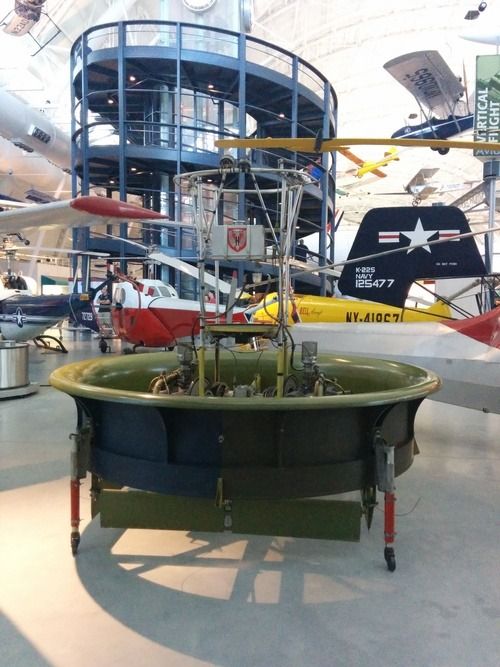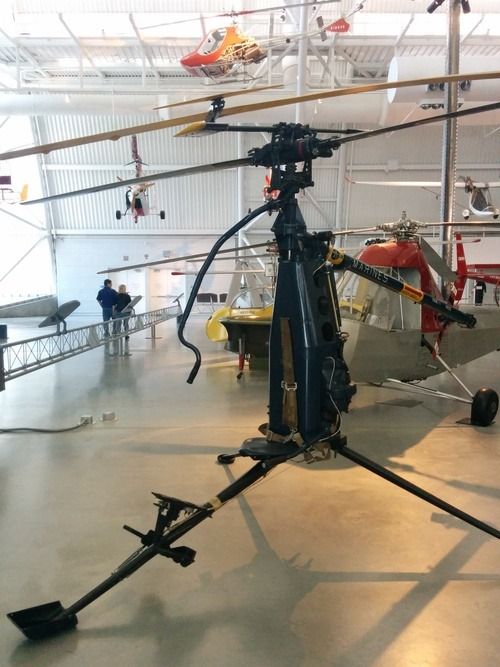Come Hiller high water
When Stephen Hiller was nineteen he designed and built the first coaxial helicopter in his parent’s driveway in Berkeley. He called it the Hiller-copter. Several years later, in 1947, he cofounded a company where he got to build all sorts of crazy variants of all things copter, including the Floating Platform (below), where the operator stood up above the center of a single giant rotor, and leaned the contraption in the direction he wanted to fly.

Yes, that’s right. In the 1950s a twenty-something created the flying Segway.

He also designed the Rotorcycle, a folding portable helicopter designed for military use. For a number of really good reasons, like its slow speed and zero protection from the elements or enemy fire, the US Army decided that it wasn’t really good for production use.
I call it a flying scooter.
Hiller was undoubtedly a genius, but in 1946 a magazine profile described him as “so utterly humorless that he never makes a joke and looks bewildered when anyone else does.”
The original misfit nerd.
Original is probably a bad word to use. Misfit nerds and geniuses ahead of their time have been around since maybe the dawn of recorded history or earlier, and even relatively well-adjusted normal intelligent people have been on the forefront of tinkering with whatever the latest in scientific or technological achievements happened to be. We used to do all sorts of crazy experiments in air travel, just as we used to do all sorts of experiments with other forms of technology, and today our experimentation continues to be in computers, and in Internet-based communications, and civic technology is a small subset of that kind of informal tinkering. Eventually, I wonder, if the corporate structure is inevitable, where no one builds their own portable aircraft from a home kit anymore because it’s all just Boeing and Lockheed now and the only profitable venture is commercial airliners and military craft.
I used to build my own computer, but now I just buy shiny prepackaged goods from Apple. We have some people at the edges, tinkering with glasses and watches and other portable, lightweight, open source gadgets, but in ten years Pebble is a publicly traded Fortune 500 company and the Arduino Corporation renovates the shell of what used to be Cisco’s campus in San Jose. So it goes.
A small civic technology startup created by former Code for America fellows has grown, over twenty years, into a medium sized software company building better products for governments. They had small offices all over the country, but then they moved everyone to Redwood City for some reason. Its CEO, the only remaining founder, is publicly charming, but none of her employees like her. They are aggressive with their sales. The software, bloated from years of miscellaneous development, begin to show rough edges as the company cuts some corners, lock in their clients and eliminate their competition. They become the villain. So it goes.
I was talking up some of this Hiller-ity to fellow civic techies (name dropping Laurenellen McCann and Justin Grimes) which soon veered elsewhere, but I’ll try to reconstruct some of their salient points with embellishments:
All this has happened before, and all this will happen again. We don’t necessarily tread new ground, us technologists. Generations of tinkerers have done what we have, learned what we are re-learning now, implemented stylistically older versions of the same thing. We are re-inventing UI elements people came up with in 1968. We may be doomed to make the same mistakes for ever.
The folly of Christopher Columbus was his belief that he was the first to discover a thing when in reality many others were there before him. Quite a few, actually, as he stumbled onto civilizations thousands of years old. We do this in technology: we “discover” things, we claim “first!,” but in reality we are treading the same well-worn paths. It is just our first time on that trail, so we brag to our friends about this fantastic trail we just discovered and what a beautiful view there is at the end of it. It is new to us. But we forget about the ones that blazed the path we’ve only now discovered for ourselves.
Oh, there was also a really good point about Robert Frost. I learned that he didn’t actually take the path less traveled. He just wished he did. That part of the poem everyone keeps repeating is taken completely out of context.
The basic nature of our instincts don’t change all that much. A thousand years ago, a Viking soldier vandalized the Hagia Sophia, scratching “Halfdan was here” into a wall. And we might have fulfilled our ultimate dream of constant self-expression, if only the original cave painters could see Instagram now. And if the purveyors of scrolls and potions could see the myriad of apps, fulfilling our human need for something: attention, companionship, love, fame, food, excitement, meaning; we create and recreate them again and again.
Sixty years from now. Yo 2.0 is simulated on a vintage iPhone 9s from the ancient 2020s, placed behind a plate of transparent aluminum in the Smithsonian. A museum technician has carefully replaced the original phone display with a holoprojector, since no one makes screens that has pixels anymore. People used to invent so much stuff for computers, surmises the visitor, a master’s candidate in artificial intelligence administration. He reflects on how different things are now. We still make software for self-expression, software for talking to friends, software for finding mates, and software to manage business logic, but now all of it designed by robots, because it’s more efficient that way. The interfaces are always the same, beautiful and functional but sterile. The robots that create them are maintained by a few giant corporations, and they’ve optimized and standardized nearly everything. Only a few people know how to write a program anymore; all of them are crazy.
So it goes.